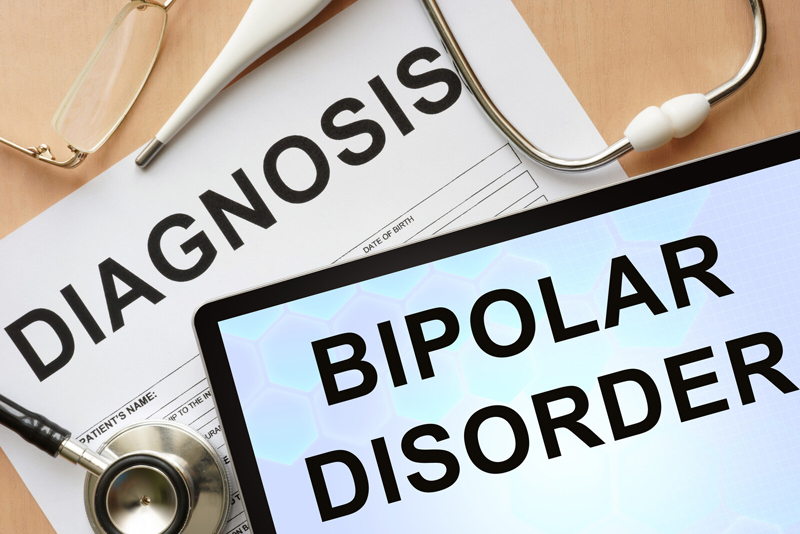Regarded as a serious mental health condition, bipolar disorder causes severe changes in a person’s mood, energy and activity levels that can make day-to-day functioning difficult. Formerly known as manic depression or manic-depressive disorder, the condition causes serious shifts in mood, thinking, behavior and energy levels – from the highs of mania on one extreme to the lows of depression on the other. When compared to ordinary mood swings, the mood changes associated with this condition are so intense that they can drastically interfere with an individual’s job or performance, create problems with relationships and disrupt their ability to function in daily life. The cycles of mood swings may occur rarely or multiple times a year and at times last for days, weeks, or months. Although, bipolar disorder is a lifelong condition, people can effectively manage the mood swings and other symptoms by correctly following a treatment plan. Treatment for this mental disorder involves a combination of medications and psychological counseling. With timely treatment and support, people can live a full and productive life. Documenting this psychiatric condition to ensure correct billing and coding can be challenging. Outsourcing medical billing services can help healthcare providers save time and submit accurate claims for optimal reimbursement.
According to the National Alliance on Mental Illness (NAMI), bipolar disorder affects over 10 million people in the United States or around 2.8% of the population. The condition affects males and females equally. The exact cause of bipolar disorder is unknown, but factors like biological differences, periods of high stress, traumatic experiences and genetics may play a prominent role. If left untreated, the condition can result in serious problems like poor work performance, problems related to drug and alcohol abuse, damaged relationships and suicidal attempts that may affect every single area of your life.
Types of Bipolar Disorder
There are three main types of bipolar disorder –
- Bipolar I – This type of disorder is characterized by at least one manic episode that may be followed by hypomanic or major depressive episodes.
- Bipolar II – More common in women, this type of disorder involves one major depressive episode that lasts at least two weeks. People also have at least one hypomanic episode that lasts about four days.
- Cyclothymia – Cyclothymic disorder patients suffer episodes of hypomania and depression. Symptoms are shorter and less severe than the mania and depression caused by bipolar I or bipolar II disorder.
- Other types – Other types of disorder include bipolar and related disorders induced by certain drugs or alcohol or due to certain medical conditions like Cushing’s disease, multiple sclerosis or stroke.
Symptoms of Bipolar Disorder
Bipolar disorder can occur at any age, and symptoms can appear during the teenage years or later in life. According to the International Bipolar Association, symptoms vary between individuals. For some people, an episode can last for several months or years. For others, people may experience “highs” and “lows” at the same time or in quick succession or will have four or more episodes within a year.
Symptoms of bipolar disorder can be divided into three stages namely – manic episode, hypomanic episode, depressive stage and psychosis stage. Hypomania and mania are elevated moods wherein mania is more intense than hypomania. Symptoms include during these elevated mood stages include –
- Underperforming at work or school
- Talking a lot and rapidly
- Sleeping little but not feeling tired
- Impaired judgment
- Having “racing” thoughts that come and go quickly
- Feeling exhilarated or euphoric
- Engaging in risky behavior
- A sense of distraction or boredom
Symptoms of depressive stage include –
- Weight loss or weight gain
- Problems with focusing and remembering
- Pain or physical problems that do not respond to treatment
- Irritability and sensitivity to noises, smells, and other things that others may not notice
- Insomnia and sleeping problems
- Extreme tiredness, fatigue, and listlessness
- Extreme sadness
- Anxiety about minor issues
- An inability to enjoy activities or interests that usually give pleasure
- A feeling of gloom, despair, and hopelessness
In severe cases, the patient may think about ending his /her life, and may act on those suicidal thoughts. In psychosis stage, people may have trouble differentiating between fantasy and reality. As per the International Bipolar Foundation, psychosis symptoms include – hallucinations, which involve hearing or seeing things that are not there and delusions, which are false but strongly felt beliefs. However, it is possible to manage all these symptoms with appropriate treatment.
Diagnosing and Treating Bipolar Disorders
Diagnosis of Bipolar disorders will be performed by a psychiatrist by comparing the symptoms using the criteria set out in the Diagnostic and Statistical Manual of Mental Disorders (DSM-5), published by the American Psychiatric Association. The National Institute of Mental Health (NIMH) explains that in order to receive a proper diagnosis of bipolar I disorder, a person must have experienced symptoms for at least 7 days, or less if symptoms were severe enough to need hospitalization. In addition, patients also need to have a depressive episode lasting at least 2 weeks. To receive a diagnosis of Bipolar Disorder II, a person needs to have experienced at least one cycle of hypomania and depression. Diagnostic evaluation may begin with a detailed physical examination and lab tests like blood and urine tests to identify other medical problems that can be causing your symptoms.
A detailed psychiatric assessment will be done wherein psychiatrists will talk with patients about their thoughts, feelings and notice their behavioral patterns. Patients will also be asked to fill out a psychological self-assessment or questionnaire. In addition, psychiatrists may ask family members or close friends about the patient’s symptoms. Patients will also be asked to maintain a clear, daily record of their moods, sleep patterns or other factors that could help with diagnosis and finding the right treatment.
A group of specialists comprising of psychologist, social worker and psychiatric nurse will help in treatment of bipolar and other related disorders. Treatment modalities aim to stabilize the person’s mood and reduce the severity of symptoms. The main goal is to help the person function effectively in daily life. A combination of medications, psychotherapy, psycho education and other support therapies will be done as part of the treatment. Medications include – Mood stabilizers, Antipsychotics, Antidepressants, Antidepressant-antipsychotic and Anti-anxiety medications. The types and dosages of medications will be prescribed based on specific symptoms. Psychotherapy treatment comprises – Interpersonal and social rhythm therapy (IPSRT), Cognitive behavioral therapy (CBT) and family focused therapy. In addition, other treatment options like electroconvulsive therapy (ECT) and Transcranial magnetic stimulation (TMS) may be added as part of depression therapy.
When documenting Bipolar disorders, psychiatrists and other mental health specialists must include the diagnosis screening tests and other treatment procedures performed using the correct medical codes. Medical billing services provided by reputable medical billing companies can help physicians use the correct codes for their billing purposes. ICD- 10 codes for bipolar disorders include –
- F31 Bipolar disorder
- F31.0 Bipolar disorder, current episode hypomanic
- F31.1 Bipolar disorder, current episode manic without psychotic features
- F31.10 Bipolar disorder, current episode manic without psychotic features, unspecified
- F31.11 Bipolar disorder, current episode manic without psychotic features, mild
- F31.12 Bipolar disorder, current episode manic without psychotic features, moderate
- F31.13 Bipolar disorder, current episode manic without psychotic features, severe
- F31.2 Bipolar disorder, current episode manic severe with psychotic features
- F31.3 Bipolar disorder, current episode depressed, mild or moderate severity
- F31.30 Bipolar disorder, current episode depressed, mild or moderate severity, unspecified
- F31.31 Bipolar disorder, current episode depressed, mild
- F31.32 Bipolar disorder, current episode depressed, moderate
- F31.4 Bipolar disorder, current episode depressed, severe, without psychotic features
- F31.5 Bipolar disorder, current episode depressed, severe, with psychotic features
- F31.6 Bipolar disorder, current episode mixed
- F31.60 Bipolar disorder, current episode mixed, unspecified
- F31.61 Bipolar disorder, current episode mixed, mild
- F31.62 Bipolar disorder, current episode mixed, moderate
- F31.63 Bipolar disorder, current episode mixed, severe, without psychotic features
- F31.64 Bipolar disorder, current episode mixed, severe, with psychotic features
- F31.7 Bipolar disorder, currently in remission
- F31.70 Bipolar disorder, currently in remission, most recent episode unspecified
- F31.71 Bipolar disorder, in partial remission, most recent episode hypomanic
- F31.72 Bipolar disorder, in full remission, most recent episode hypomanic
- F31.73 Bipolar disorder, in partial remission, most recent episode manic
- F31.74 Bipolar disorder, in full remission, most recent episode manic
- F31.75 Bipolar disorder, in partial remission, most recent episode depressed
- F31.76 Bipolar disorder, in full remission, most recent episode depressed
- F31.77 Bipolar disorder, in partial remission, most recent episode mixed
- F31.78 Bipolar disorder, in full remission, most recent episode mixed
- F31.8 Other bipolar disorders
- F31.81 Bipolar II disorder
- F31.89 Other bipolar disorder
- F31.9 Bipolar disorder, unspecified
Even though there is no definite way to prevent bipolar disorders, undergoing the right treatment at an early stage can help prevent the condition from worsening. By following certain lifestyle strategies, people diagnosed with this disorder can prevent minor symptoms from becoming full-blown episodes of mania or depression. These strategies include – maintaining a regular routine, avoiding alcohol or drugs, paying attention to warning signs, establishing a regular sleep pattern, taking steps to prevent sleep disturbance and taking medications as prescribed by the psychiatrists.
Psychiatry medical billing and coding can be challenging and therefore requires a clear understanding about the highly specific medical codes. Physicians can rely on the services of a reliable billing and coding company to submit claims for optimal reimbursement.




